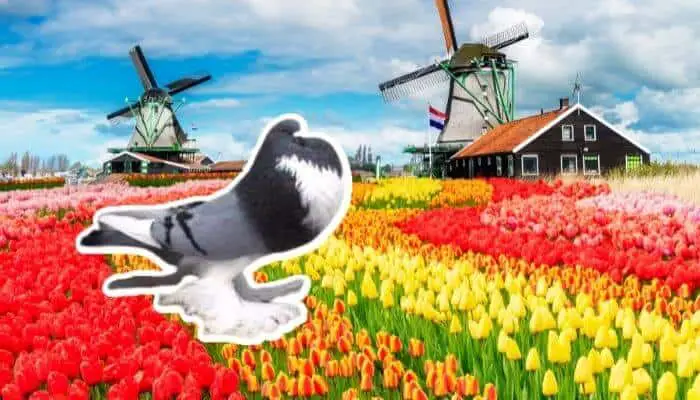The Dutch Cropper pigeon is a breed of fancy pigeon that boasts the title of being the oldest and largest type of fancy pigeon in the Netherlands!
It is a large, impressive looking pigeon with a balloon chest and well-feathered legs.
Origins of the Dutch Cropper
Though the name of the bird very much suggests and cements the fact that the species originated in the Netherlands, the exact details of the development of the Dutch Cropper pigeon are not very clear.

Literature mentioning “the great Croppers with muffs at the Batavians” (Batavia is an old geographical area of The Netherlands and Belgium) dates back to at least 1600, with more writing on what is assumed to be the modern iteration of the Dutch Cropper pigeon continuing through the 17th, 19th and 20th centuries.
In terms of ancestry, the Dutch Cropper pigeon shares resemblances with the Ghent Cropper, Pomeranian Pouter, English Pouter, French Pouter and Saxon Pouter and this is represented by its former name of Old Holland Pouter. All of these birds date back to at least 400 years ago in mainland Europe.
The Dutch Cropper is a fancy breed that is now mainly kept for exhibition purposes.
Distribution And Habitat of the Dutch Cropper
The Netherlands is the native homeland of the Dutch Cropper pigeon, but over the centuries there is no doubt that certain variants of the breed have been present across neighbouring countries on the European mainland.
In more modern times, the nature of the breed being classed as a fancy pigeon means that the large majority of the Dutch Cropper pigeon population are not kept in domestic settings rather than being in the wild.
Appearance of the Dutch Cropper
The largest breed of fancy pigeon in The Netherlands, the Dutch Cropper has a proud impressive stance.
The Dutch Cropper pigeon has an almost horizontal stance with smooth and well-closed feathers on its body.
The back is broad and slopes slightly in a straight line from broad shoulders.
The wings cover the back well and are also broad and well closed.
Broad is also the best description of the tail which is long but not so as to touch the floor.
Their beaks are of a medium length with a colour that matches their feathers.
This breed has a wide colour range. Self-coloureds are white yellow and black and then there are numerous variations within the barred, pied and tiger patterns.
The eye has a dark red/orange iris. Cere are small and fine.
Dutch Croppers have two main distinguishing features – their “balloon” and leg feathers.
The balloon sits in a long neck, flowing seamlessly into a broad and fleshy chest and is so named because it looks like an inflated balloon. It is often called the bladder but is in fact an inflatable crop.
The muff feathering on the comparatively longish legs should be well developed with breed standards looking for opulence and breadth and feathers that are smooth and closed.
There should also be an abundance of thigh feathers.
Character of the Dutch Cropper
Dutch Cropper pigeons are known for being very lively birds that have a lot of natural confidence.
That being said, their temperament is still very calm and quiet despite their confidence, and they are known to be very friendly in nature to humans especially.
This combination of positive character traits makes the Dutch Cropper an ideal pet pigeon or starter bird for an inexperienced fancier.
They are also hardy birds, suffering no adverse effects of the harsh North European winters.
The Dutch Cropper Diet
There are no special dietary requirements for this breed.
It eats what a pigeon eats when in a domestic environment.
The pigeon owner will make up their own mix or buy a proprietary mix which will include a combination of grains, seeds and nuts and may be supplemented with vegetables, fruit, berries and any treats the owner decides upon.
Favourites include popcorn and bananas.
They also need a regular source of clean, fresh water and perhaps, grit for digestion.
Mating And Breeding Dutch Cropper Pigeons
Being a breed that is primarily used for the purpose of shows and exhibitions, the mating and breeding of Dutch Cropper pigeons is very much controlled by the owners and breeders.
Mating pairs are selected based on ideal traits and characteristics that breeders want to continue in the line, and these are usually size, temperament, colouring and overall resilient and enduring health.
One of the main issues for breeders is with pied colour varieties.
Under the breed standards, Dutch Croppers should not have wing rosettes but they commonly appear.
The breeder is allowed to remove them but if there are too many, colours will begin to show. This will mean they won’t be a good exhibition bird.
Taking Care of Dutch Cropper Pigeons
The temperament and behaviour of a Durch Cropper make it an ideal subject for beginner pigeon keepers.
Maintenance of the breed is also very stress-free and conventional.
Besides needing potentially more food in order to accommodate for their larger size, the Dutch Cropper will thrive when kept in a traditional domestic pigeon setting.
A clean habitat, access to direct sunlight, and access to plenty of fresh food and drinking water should do the trick!
If you are familiar with what this kind of traditional setup involves, then you already know how to take care of a Dutch Cropper.
